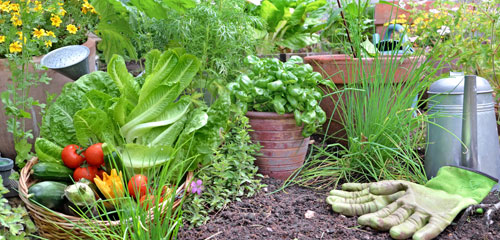Who could have predicted tomatoes would become worth their weight in gold?
We’ve seen arguments break out about whether the shortage of fresh produce in the UK is caused by Brexit, supermarkets, or cold weather in Spain. Regardless of the cause, you could do a lot worse than seeking solace in the garden. Time to grow your own salads.
Gardening is relaxing, rewarding, and a great way to bond with curious kids or grandkids. And you don’t need acres of garden to do it. If there’s one thing lockdown has taught us, it’s to make the best of the space you’ve got.
It’s time to get started
March and April are great months for planting a range of edible crops, no matter how much or how little space you have. Patience is, as ever, a virtue – you’re not going to be able to pop a few seeds in the ground and magically have enough tomatoes for a Greek salad next week. But the good news is that there are plenty of things that can go in the ground now. Or into pots or window boxes if space is tight – just in time for some spring sunshine.
Beetroot: Beetroot does best when planted in cooler weather, so try and get your seeds in the ground while March still feels like December. It needs low temperatures to germinate, and you will need a bit of space. The seeds are sown just 1 cm below the surface, but they should be placed 10 cm apart with 30 cm between rows.
Carrots: Once we’re into April, you can plant carrots in shallow drills in the ground. Or if space is tight and you’re happy with a shorter, rounder carrot, they do well in pots. Expect to harvest your carrots in July or August. If your soil is stony, swap it out for something softer – unless you find forked carrots amusing.
Chillies: These tend to do better in pots than in the ground. Especially if you have a nice, sunny spot. This means that you don’t even need a balcony, as chillies are perfectly happy on windowsills. They also do well in greenhouses, but if you don’t have the room or the funds, you can make a mini greenhouse. Try covering the indoor pots with a clear plastic bag secured with a rubber band until the seedlings sprout.
Chives: At home in either pots or the ground, chives are wonderfully easy to grow. They grow pretty quickly, and a quick snip with a pair of scissors is all that’s required to harvest a handful to add flavour to everything from a pasta sauce to a salad to the dollop of sour cream on a baked potato. If you’re into bees – and if you’re not, you should be – the pretty purple flowers are good for attracting industrious little pollinators to a garden.
Cucurbits: This is a collective term for cucumbers, marrows, courgettes, and pumpkins. They should be started off in small pots under cover and then you can move them outside (or into a greenhouse in the case of cucumbers) once we’re safely out of the frost season.
Leeks: The national vegetable of Wales! And a less teary, easy-chopping alternative to onions! You do need a bit of space for leeks. But if you plant them in April, you should be rewarded with an autumn crop. Do not plant them too close together – your correspondent speaks from bitter experience. They were skinny and very disappointing. Some of them grew really high – nobody really needs a four-foot high spindly leek.
Peppers: Like chillies, peppers are happiest in pots. And like chillies, peppers appreciate a sunny spot, an actual greenhouse or a mini greenhouse (see chillies above). With peppers among the main items that have been running low in shops, homegrown peppers are a good investment for the months ahead.
Potatoes: Commonly associated with large fields on farms, you don’t need to buy up half the county to successfully grow spuds. They do well in the ground in pretty much any plot of soil, as well as sacks or large pots. Just make sure you’re generous with the compost no matter where you put them. You can even start the potato process indoors by putting the seed potatoes in seed trays on a windowsill in a cool room that gets plenty of light. Give it a few weeks and the sprouting seed potatoes can then be moved to their permanent home.
Spinach, chard and kale: These leaves of green goodness grow well in containers, so they are a good option for small gardens that are more paving stone than soil. Whether you pop them in the ground or in a container, cover the top of the soil with a layer of compost.
Tomatoes: Plant these in March and April. They grow quite easily, with cherry, tumbling, and bush varieties doing well in pots, growing bags, or the ground. Use a peat-free multi-purpose compost, make sure they get plenty of sun and give them plenty to drink.
It has been said that tomatoes are a lot of work just so you can save about £3, but if you end up with a prolific crop, you can end up with more tomatoes than you bargained for. That said, if you do end up with a surplus, they freeze well, either whole or as a puree for easy sauces, stews and curries.



